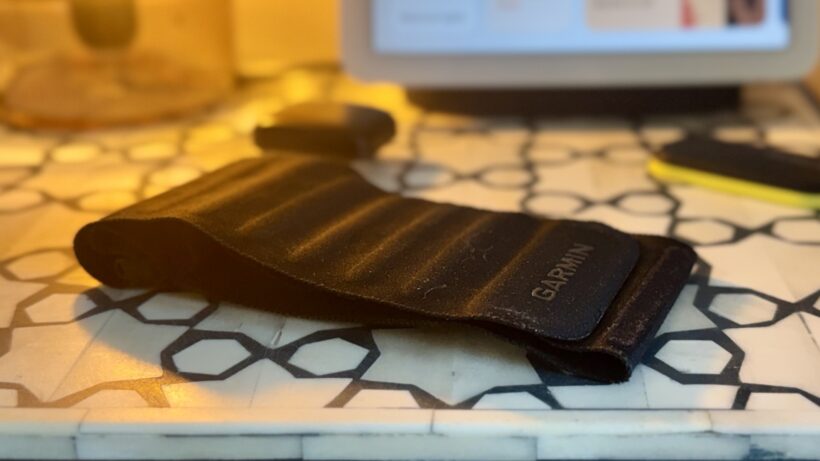An excellent alternative to wrist-based Garmin sleep tracking—at a price
The Garmin Index Sleep Monitor is a niche but powerful accessory that solves a long-standing problem for dedicated Garmin users: how to get sleep data without wearing a bulky watch to bed. It works brilliantly, delivering more true-to-feel sleep data than any Garmin watch we've tested, which in turn makes ecosystem metrics like Training Readiness and HRV Status more reliable. However, underwhelming battery life and its single-use nature make it a considered, and expensive, purchase for data-obsessed Garmin users only.
Pros
- Superior sleep tracking accuracy
- Unlocks more from recovery metrics
- Comfortable alternative to wearing a Garmin watch
Cons
- Disappointing battery life
- Sleeve design feels overly large
- Steep price for a single-function tracker
For years, a paradox has existed at the heart of the Garmin ecosystem.
On one hand, you have some of the most powerful and comprehensive training and recovery metrics in the business—HRV Status, Training Readiness, Body Battery—all designed to give you a holistic view of your readiness to perform.
On the other hand, the crucial sleep data that underpins these features has often been a weak link, especially when compared to the industry’s best sleep trackers like Oura and Whoop.
Enter the Garmin Index Sleep Monitor, the company’s first screenless tracker and a wearable device with a very specific mission: to alleviate the pain points of the brand’s sleep tracking.
This isn’t a Whoop-style, all-day activity tracker. It does one job, and one job only. It’s for the dedicated Fenix, Instinct, or Forerunner user who loves their watch during the day but finds it too cumbersome to wear at night.
It’s a concept that taps into the growing trend of multi-device ecosystems. And while it is niche, it also feels perfectly on-brand for a company that has launched an actual fitness tracker for horses in the last few weeks.
But the key question is a simple one: is the promise of better data worth strapping on yet another device every night (and charging it)? After six weeks of testing, the answer is a firm yes—but it’s slightly complicated.
Design, fit, and comfort

The Index Sleep Monitor is a simple affair: a small, removable sensor puck that slots into a soft, stretchy armband made from a blend of nylon and spandex. The band comes in two sizes and uses a velcro system to secure it around your upper arm. It’s a design that prioritizes comfort, avoiding any rigid plastic that could dig in during the night—and it works well from that perspective.
Garmin advises wearing it on the outside of your upper arm, and, for side sleepers, to place it on the arm you’re less likely to lie on. Getting this positioning right is crucial. I haven’t encountered any issues with missing data due to the fit. However, other testers on the Wareable team have experienced occasional nights of missing data resulting from a poor fit.
This makes sense, in a way; being a screenless device, it isn’t always clear whether it’s ready to track. There is a status indicator on the rear of the device to help. Yet, its positioning (which I can appreciate is to avoid any interruptions to your sleep) ensures the only way to tell if it’s working once strapped on is to lift it and see if the sensor array (or the indicator itself) is lit up.
I’ve only experienced one issue with the design’s function and registering sleep. One night, I took it off charge immediately before getting into bed, and it didn’t wake up and register any data. From then, I got into the habit of rapidly tapping the sensor once strapped on to ensure it was awake, and haven’t experienced any issues.
Learning curve
Once you get the hang of these foibles and how tight to strap it on (so it doesn’t come loose during the night against bed sheets), the device is generally very comfortable. Similar to the Whoop Bicep Band I’ve had strapped on for the last three years or so, it’s a tracker that very much blends into the background once you get used to the initial feeling.

Mercifully, but also essentially, the band itself is machine washable. And although the sensor is waterproof up to 50 meters, it’s not recommended for the laundry pile. Instead, I’ve just been wiping it down on occasion to avoid the sensor getting too grimy—similar to a Garmin watch.
My only long-standing gripe with the design during testing has been the size; the band feels a little wider than it needs to be to hold such a small sensor. And while I appreciate this likely helps keep it stable and distributes the security on the arm without having to really lock down the fit, a more streamlined profile would be welcome in a future version.
Overall, though, the Index Sleep Monitor feels premium, is comfortable, and has shown no signs of degradation over the last six weeks of nightly wear (and washes every week or so).
Sleep tracking and performance: A deep dive into the data

Being a single-function device, this is where the Index Sleep Monitor earns its keep. In short, the sleep data it produces is a definite incremental improvement over what I’ve experienced from a Garmin watch in the last few years.
It might not sound worth it, based on that. However, given the brand is constantly expanding the insights into which its sleep tracking feeds into, even this slight upgrade in sleep staging or time in bed detection has proven to have a considerable trickle-down effect on the metrics across the ecosystem.
To try and quantify this, I’ve compared a clear baseline of my sleep data (from the Forerunner 970) before diving into the six weeks of Index Sleep Monitor testing.
Everybody’s sleep data is different, of course, but the averages below are very representative of the figures I’ve seen from Garmin for years. As I’ve explored in countless reviews over that time, and in our guide to the best sleep trackers, Garmin has consistently underreported my ‘restorative’ sleep time (i.e., REM and deep sleep).
A note on sleep stage analysis
Here at Wareable, we traditionally don’t put too much stock into sleep stage analysis from any brand. When even the gold standard of measurement—polysomnography—is an imprecise science, and the best consumer sleep trackers are operating at ~80% accuracy, it’s often relatively fruitless to analyze whose interpretation is best.
However, I also want to caveat that. As I’ll explore in much more detail below, there are still some positives to the game of trying to analyze sleep stages… and, in doing so, it means the Index Sleep Monitor is a better match for industry rivals than any watch from the brand.
The baseline: Two weeks of data from the Forerunner 970

To understand what the Index Sleep Monitor is up against, I tracked 14 consecutive nights using the Forerunner 970, Garmin’s flagship running watch, which features the latest sensors (although, at the time, it didn’t yet include the newest sleep features just announced as part of the Venu 4).
Again, these results were typical of our long-term experience with Garmin wearables. Over the 14-night period, the Forerunner 970 produced the following averages:
- Deep sleep: 1 hour 25 minutes
- REM sleep: 1 hour 13 minutes
- Light sleep: 5 hours 1 minute
- Awake time: 10 minutes
- Average Total ‘restorative’ sleep (deep + REM): 2 hours 38 minutes
For context, during the same period, our Whoop MG tracker reported an average of 1 hour and 52 minutes of deep sleep and 1 hour and 14 minutes of REM, for a total restorative sleep of 3 hours and 6 minutes.
The discrepancy I’ve often noted is apparent even in a small sample size; the Forerunner 970 underreported my total restorative sleep by around 30 minutes a night… but, really, that all came from underestimating deep sleep.
Good enough—but no longer the best solution
Now, to be clear, Garmin’s sleep data from the wrist is still very usable most of the time, even with the odd night of underreporting in some areas like this.
Insights like the Sleep Score, or the knock-on metrics such as Training Readiness, are generally in the right ballpark to trust—even if they don’t align as closely as data from Oura, Apple, and Whoop.
However, there are definitely still some sleep sessions—anomalies—where sleep stage analysis is clearly off (e.g., less than 10 minutes of deep or REM detected), resulting in a very low sleep score, advice to take it easy on training, or skewed Sleep Coach suggestions.
The six-week test with the Index Sleep Monitor

Switching to the Index Sleep, the improvement was immediately noticeable and consistent. Over a 43-night testing period, the data painted a different picture.
It produced the following averages:
- Deep sleep: 1 hour 7 minutes
- REM sleep: 1 hour 59 minutes
- Light sleep: 5 hours 25 minutes
- Awake time: 13 minutes
- Average Total ‘restorative’ sleep (deep + REM): 3 hours 6 minutes
The crucial number here is the total restorative sleep. At 3 hours and 6 minutes, the Index Sleep Monitor’s average is almost identical to the benchmark set by my Whoop over the same period (3 hours and 1 minute).
It achieves this by rebalancing the sleep stages—significantly increasing the recorded REM sleep while slightly (and initially, to me, surprisingly) decreasing deep sleep—to arrive at a far more credible and consistent total.
With a more accurate foundation, my Sleep Score now feels more aligned with my subjective feeling of restfulness. And, again, core metrics like Training Readiness and Body Battery feel more trustworthy.
As a result, I’ve not felt the same surprise on some mornings when checking Garmin Connect, and then the subsequent need to cross-reference a strangely low Garmin score with Oura or Whoop before deciding on the day’s training intensity.
Not without issue, but still a step above
The system isn’t infallible, of course. I still recorded one anomaly, a night where the Index Sleep logged just 20 minutes of deep sleep—a classic quirk reminiscent of watch-based tracking. However, this is still far less frequent than I’m used to using a Garmin watch.
A perfect case study occurred during my testing, too. With the Index Sleep out of battery, I wore my Fenix 8 Pro.
The watch recorded just 54 minutes of deep sleep and 33 minutes of REM sleep, producing a poor Sleep Score that negatively impacted my Training Readiness score for the day, despite feeling well-rested (and Apple, Oura, and Whoop offering more generous sleep stage analyses).
It was a stark, one-night demonstration of the very problem the Index Sleep Monitor is designed to solve. It provides cleaner, more consistent data that Garmin’s powerful recovery features deserve and require.
Battery life and charging

For a device with no screen, no GPS, and a single, focused task, the battery life of the Index Sleep Monitor is surprisingly weak. In our testing, the device consistently lost around 25% of its charge each night, giving it a total lifespan of just four nights.
Garmin officially claims up to seven nights, but, sleeping for between 7 and 9 hours per night, I was never able to achieve anywhere close to that figure. Another Wareable tester, who averages far less time in bed than I (a consistent 6-hour sleeper), did manage to get another day of life. That adds up, given that the overall tracking time used is roughly the same.
While it’s not a complete dealbreaker—you don’t wear it during the day, so charging is less of an inconvenience—it still feels like an unforced error. A device like this should comfortably last for two weeks, if not a month, which means that opting for the Index Sleep Monitor is also a vote to add another device to your charging routine and schedule. That won’t be for everybody.
It’s unclear what the culprit is here, and this is especially curious given Garmin’s typically class-leading battery life in watches. However, I would hazard a guess that it has something to do with SpO2 tracking. This is still traditionally an area that saps battery life in wearables—but, at the time of writing, there’s unfortunately no way to disable it on the Index Sleep to double-check.
Summary: Should you buy the Index Sleep Monitor?
The Garmin Index Sleep Monitor is a device that is both brilliantly effective and narrowly focused.
It solves a genuine and long-standing problem for a particular type of Garmin user—the data-driven type committed to the ecosystem that finds sleeping with their watch to be too uncomfortable.
The improvement in sleep data accuracy is incremental, but it’s also a leap that elevates the entire Garmin experience, making flagship recovery metrics more meaningful and trustworthy.
That performance is let down by bafflingly poor battery life and the simple fact that it’s another expensive, single-use device to manage. It’s a costly but ultimately successful solution to a particular Garmin problem.





